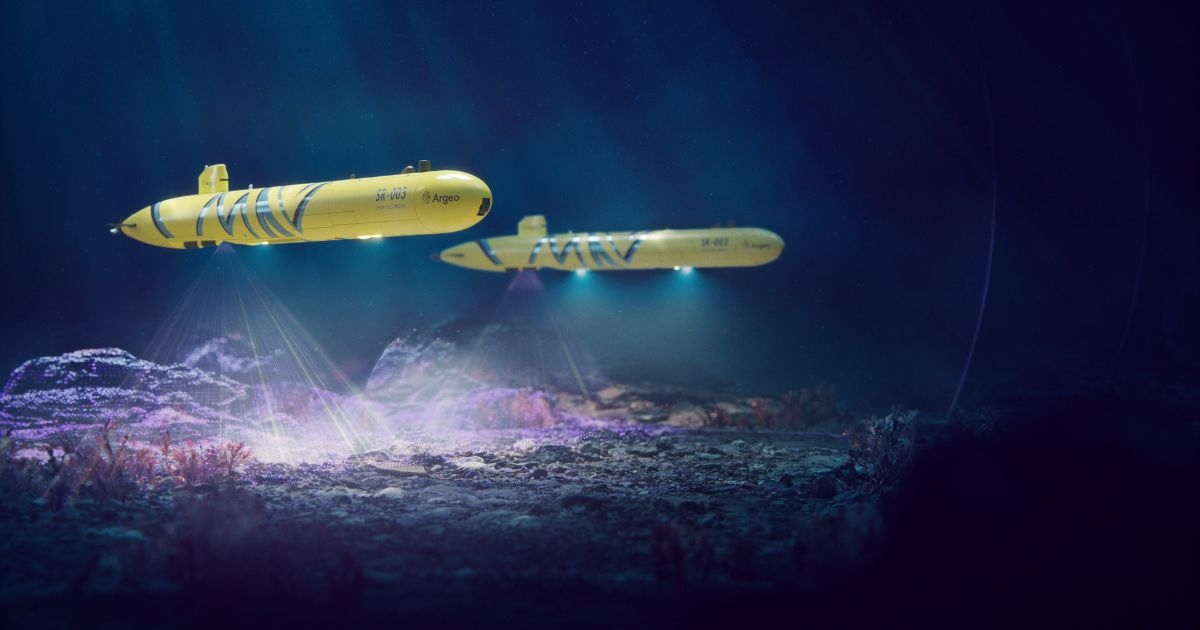The Swiss Army Knife of Underwater Inspection: AN Autonomous Robot Transforming Ocean Survey

A sophisticated package of electromagnetic sensors developed by Norwegian company Argeo is radically improving the monitoring of power cables, pipelines, and wind turbine foundations, the scanning for buried UXO, and the mapping of deep-sea minerals.
Furthermore, by fitting the sensors into an autonomous underwater vehicle capable of doing, for example, cable inspection at 6 km/h, Argeo is setting new efficiency standards in the ocean inspection arena.
The SeaRaptor 6000 is an impressive piece of machinery. The yellow, survey grade deep water autonomous underwater vehicle (AUV) is built to operate at abyssal depths. Able to reach 6,000 m, the AUV carries a package of sensors that will radically change geophysical and hydrographic surveying, according to Argeo CEO Trond Crantz:
“We’ve developed a unique array of electromagnetic tools, patent pending, that will transform the way ocean survey and inspection is performed.
“Our sensors will provide data for assessing the condition of subsea infrastructure and for surveying the seabed. The data produced will be more detailed and precise than conventional methods, and we can do it much faster. On top of that, we can operate largely without surface vessels. We’ve presented this strong technology combo to several offshore wind and oil & gas companies, and they’re considering this a gamechanger in the industry.”
REDUCING VESSEL TIME
The Argeo mission is to go smaller, smarter, and more sustainable. By replacing large, expensive, and labour-intensive surface vessels with small, autonomous underwater vehicles, Argeo offers the oil & gas and offshore wind industries a way to substantially reduce the effort needed to inspect subsea assets and infrastructure.
According to Trond Crantz, currently 90% of these costs are vessel related; he estimates that by deploying the SeaRaptor 6000 and similar advanced inspection tools, operators can replace up to 70% of all vessel activities.
And that is good news to the sector, because it’s searching high and low for solutions that drive operational efficiency while helping to reduce the cost of survey and inspection. Not least to deliver on the increasingly important parameters of sustainability and ESG.
INSPECTION OF CATHODIC PROTECTION
The newly developed electromagnetic sensor package will be integrated into the SeaRaptor 6000, built by Teledyne Gavia, and into the rest of the AUV fleet in time. An additional SeaRaptor 6000 will be joining the Argeo AUV fleet soon.
Argeo’s SeaRaptor 6000 and its sensor package will soon be heading out to its first commercial assignment, using its hypersensitive tools for inspection of the Cathodic Protection of pipelines.
While the AUV moves along the pipeline, its electromagnetic sensors measure the electric currents from the pipeline’s sacrificial anodes. In this way, it assesses the condition of the anodes and can pinpoint which ones are ready for replacement. The system can also be used for monitoring power cables, and for detecting oil or gas leaks. The AUV performs its task at a speed of 6 km per hour, 5 times faster than conventional methods.
UXO DETECTION
In addition to inspecting Cathodic Protection, Argeo sensors can detect unexploded ordnance.
“Up to now you use passive magnetometer systems on large surface vessels, to locate this kind of metallic objects. The method is time consuming, expensive, and inaccurate,” Trond Crantz explains.
“To detect UXO, we’ve extended the scope of our sensor system. For inspection of Cathodic Protection, we’re using a passive system. To detect UXO, we’re making it active: we’re not only listening to a signal, but we’re also sending a signal out and measuring the reflections coming back. The electromagnetic field our AUV is transmitting while moving across the ocean floor, will reveal objects weighing 1-3 kg and upwards, buried in the sediment. We can detect UXO with high accuracy, and even make a 3D map of its location. Pinpointing a small metallic object, at that speed and with that radius—our system is the only in the world able to do that.”
Furthermore, the Argeo AUV can track a pipeline, or a power cable buried up to 2 m below the sea floor. Apart from reporting about its condition, for instance a leak or a rupture, the sensors estimate how deep it is buried and reveal if it has been exposed by sediment shift.
While monitoring the pipeline, the AUV is not dependent on a preprogrammed path but can track the cable autonomously without any input from the surface. Its steering algorithm navigates using input from the electromagnetic sensors and the AUV will follow the cable or pipeline closely, even if its actual position differs from where it’s supposed to be.
MAPPING DEEP-SEA MINERALS
Argeo’s technology can be adapted to work on a very large scale and can even be implemented to support the seabed mapping of deep-sea minerals by connecting two SeaRaptors, one functioning as a Source AUV, the other as a Receiver AUV. Together they can map the conductive layers in which minerals can be found, down to a depth of 100 m below the ocean floor and produce a 3D map of the area. Argeo is the only company in the world that can perform such surveys, with technology implemented in an AUV. And we can do it at depths up to 6.000 m.
“All in all, we can help tackle a wide variety of the challenges the offshore industry is facing, when it comes to survey and inspection, says Trond Crantz.
“Merging unique sensor technology with autonomous surface and underwater vehicles, powered by sophisticated algorithms, allows us to introduce a fully automated, highly sensitive survey and inspection solution. Now we can dramatically improve efficiency and imaging quality, and what’s more, we can significantly reduce emissions related to survey and inspection.”
For more information, visit: www.argeo.no.
This feature originally appeared in Ocean News & Technology's Magazine May 2022 edition—Subsea IMR Technology. To read more, access the magazine here.

